[English] 日本語
 Yorodumi
Yorodumi- PDB-7kha: Cryo-EM Structure of the Desulfovibrio vulgaris Type I-C Apo Cascade -
+ Open data
Open data
- Basic information
Basic information
| Entry | Database: PDB / ID: 7kha | |||||||||
|---|---|---|---|---|---|---|---|---|---|---|
| Title | Cryo-EM Structure of the Desulfovibrio vulgaris Type I-C Apo Cascade | |||||||||
 Components Components |
| |||||||||
 Keywords Keywords | RNA BINDING PROTEIN/RNA / CRISPR / Cascade / RNA BINDING PROTEIN-RNA complex | |||||||||
| Function / homology |  Function and homology information Function and homology informationmaintenance of CRISPR repeat elements / endonuclease activity / defense response to virus / Hydrolases; Acting on ester bonds / RNA binding Similarity search - Function | |||||||||
| Biological species |  Desulfovibrio vulgaris (bacteria) Desulfovibrio vulgaris (bacteria) Desulfovibrio vulgaris str. Hildenborough (bacteria) Desulfovibrio vulgaris str. Hildenborough (bacteria) | |||||||||
| Method | ELECTRON MICROSCOPY / single particle reconstruction / cryo EM / Resolution: 3.13 Å | |||||||||
 Authors Authors | O'Brien, R. / Wrapp, D. / Bravo, J.P.K. / Schwartz, E. / Taylor, D. | |||||||||
| Funding support |  United States, 2items United States, 2items
| |||||||||
 Citation Citation |  Journal: Nat Commun / Year: 2020 Journal: Nat Commun / Year: 2020Title: Structural basis for assembly of non-canonical small subunits into type I-C Cascade. Authors: Roisin E O'Brien / Inês C Santos / Daniel Wrapp / Jack P K Bravo / Evan A Schwartz / Jennifer S Brodbelt / David W Taylor /  Abstract: Bacteria and archaea employ CRISPR (clustered, regularly, interspaced, short palindromic repeats)-Cas (CRISPR-associated) systems as a type of adaptive immunity to target and degrade foreign nucleic ...Bacteria and archaea employ CRISPR (clustered, regularly, interspaced, short palindromic repeats)-Cas (CRISPR-associated) systems as a type of adaptive immunity to target and degrade foreign nucleic acids. While a myriad of CRISPR-Cas systems have been identified to date, type I-C is one of the most commonly found subtypes in nature. Interestingly, the type I-C system employs a minimal Cascade effector complex, which encodes only three unique subunits in its operon. Here, we present a 3.1 Å resolution cryo-EM structure of the Desulfovibrio vulgaris type I-C Cascade, revealing the molecular mechanisms that underlie RNA-directed complex assembly. We demonstrate how this minimal Cascade utilizes previously overlooked, non-canonical small subunits to stabilize R-loop formation. Furthermore, we describe putative PAM and Cas3 binding sites. These findings provide the structural basis for harnessing the type I-C Cascade as a genome-engineering tool. | |||||||||
| History |
|
- Structure visualization
Structure visualization
| Movie |
 Movie viewer Movie viewer |
|---|---|
| Structure viewer | Molecule:  Molmil Molmil Jmol/JSmol Jmol/JSmol |
- Downloads & links
Downloads & links
- Download
Download
| PDBx/mmCIF format |  7kha.cif.gz 7kha.cif.gz | 511.7 KB | Display |  PDBx/mmCIF format PDBx/mmCIF format |
|---|---|---|---|---|
| PDB format |  pdb7kha.ent.gz pdb7kha.ent.gz | 419.6 KB | Display |  PDB format PDB format |
| PDBx/mmJSON format |  7kha.json.gz 7kha.json.gz | Tree view |  PDBx/mmJSON format PDBx/mmJSON format | |
| Others |  Other downloads Other downloads |
-Validation report
| Summary document |  7kha_validation.pdf.gz 7kha_validation.pdf.gz | 1.3 MB | Display |  wwPDB validaton report wwPDB validaton report |
|---|---|---|---|---|
| Full document |  7kha_full_validation.pdf.gz 7kha_full_validation.pdf.gz | 1.3 MB | Display | |
| Data in XML |  7kha_validation.xml.gz 7kha_validation.xml.gz | 95.2 KB | Display | |
| Data in CIF |  7kha_validation.cif.gz 7kha_validation.cif.gz | 143.4 KB | Display | |
| Arichive directory |  https://data.pdbj.org/pub/pdb/validation_reports/kh/7kha https://data.pdbj.org/pub/pdb/validation_reports/kh/7kha ftp://data.pdbj.org/pub/pdb/validation_reports/kh/7kha ftp://data.pdbj.org/pub/pdb/validation_reports/kh/7kha | HTTPS FTP |
-Related structure data
| Related structure data |  22876MC M: map data used to model this data C: citing same article ( |
|---|---|
| Similar structure data |
- Links
Links
- Assembly
Assembly
| Deposited unit | 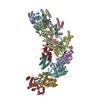
|
|---|---|
| 1 |
|
- Components
Components
| #1: Protein | Mass: 25250.969 Da / Num. of mol.: 1 Source method: isolated from a genetically manipulated source Source: (gene. exp.)  Desulfovibrio vulgaris (strain Hildenborough / ATCC 29579 / DSM 644 / NCIMB 8303) (bacteria) Desulfovibrio vulgaris (strain Hildenborough / ATCC 29579 / DSM 644 / NCIMB 8303) (bacteria)Strain: Hildenborough / ATCC 29579 / DSM 644 / NCIMB 8303 / Gene: DVUA0130 / Plasmid: D. vulgaris Cascade/I-C (Cas5c-Cas8c-Cas7)/pHMGWA / Production host:  | ||||||
|---|---|---|---|---|---|---|---|
| #2: Protein | Mass: 32358.912 Da / Num. of mol.: 7 Source method: isolated from a genetically manipulated source Source: (gene. exp.)  Desulfovibrio vulgaris (strain Hildenborough / ATCC 29579 / DSM 644 / NCIMB 8303) (bacteria) Desulfovibrio vulgaris (strain Hildenborough / ATCC 29579 / DSM 644 / NCIMB 8303) (bacteria)Strain: Hildenborough / ATCC 29579 / DSM 644 / NCIMB 8303 / Gene: DVUA0132 / Plasmid: D. vulgaris Cascade/I-C (Cas5c-Cas8c-Cas7)/pHMGWA / Production host:  #3: Protein | | Mass: 59310.883 Da / Num. of mol.: 1 / Fragment: UNP residues 80-612 Source method: isolated from a genetically manipulated source Source: (gene. exp.)  Desulfovibrio vulgaris (strain Hildenborough / ATCC 29579 / DSM 644 / NCIMB 8303) (bacteria) Desulfovibrio vulgaris (strain Hildenborough / ATCC 29579 / DSM 644 / NCIMB 8303) (bacteria)Strain: Hildenborough / ATCC 29579 / DSM 644 / NCIMB 8303 / Gene: DVUA0131 / Plasmid: D. vulgaris Cascade/I-C (Cas5c-Cas8c-Cas7)/pHMGWA / Production host:  #4: Protein | Mass: 14017.981 Da / Num. of mol.: 2 / Fragment: Cas8c C-terminal domain (UNP residues 489-612) Source method: isolated from a genetically manipulated source Source: (gene. exp.)  Desulfovibrio vulgaris (strain Hildenborough / ATCC 29579 / DSM 644 / NCIMB 8303) (bacteria) Desulfovibrio vulgaris (strain Hildenborough / ATCC 29579 / DSM 644 / NCIMB 8303) (bacteria)Strain: Hildenborough / ATCC 29579 / DSM 644 / NCIMB 8303 / Gene: DVUA0131 / Plasmid: D. vulgaris Cascade/I-C (Cas5c-Cas8c-Cas7)/pHMGWA / Production host:  #5: RNA chain | | Mass: 14457.629 Da / Num. of mol.: 1 Source method: isolated from a genetically manipulated source Source: (gene. exp.)  Desulfovibrio vulgaris str. Hildenborough (bacteria) Desulfovibrio vulgaris str. Hildenborough (bacteria)Strain: Hildenborough / ATCC 29579 / DSM 644 / NCIMB 8303 / Plasmid: D. vulgaris sp2 CRISPR/pACYCDuet-1 / Production host:  |
-Experimental details
-Experiment
| Experiment | Method: ELECTRON MICROSCOPY |
|---|---|
| EM experiment | Aggregation state: PARTICLE / 3D reconstruction method: single particle reconstruction |
- Sample preparation
Sample preparation
| Component | Name: Type I-C Apo Cascade / Type: COMPLEX / Details: Minimal CRISPR Cascade / Entity ID: all / Source: RECOMBINANT |
|---|---|
| Molecular weight | Value: 0.371 MDa / Experimental value: YES |
| Source (natural) | Organism:  Desulfovibrio vulgaris (strain Hildenborough / ATCC 29579 / DSM 644 / NCIMB 8303) (bacteria) Desulfovibrio vulgaris (strain Hildenborough / ATCC 29579 / DSM 644 / NCIMB 8303) (bacteria)Strain: Hildenborough / ATCC 29579 / DSM 644 / NCIMB 8303 |
| Source (recombinant) | Organism:  |
| Buffer solution | pH: 7.5 |
| Specimen | Conc.: 0.3 mg/ml / Embedding applied: NO / Shadowing applied: NO / Staining applied: NO / Vitrification applied: YES |
| Specimen support | Grid material: COPPER / Grid type: C-flat-2/2 |
| Vitrification | Instrument: FEI VITROBOT MARK IV / Cryogen name: ETHANE / Humidity: 100 % / Chamber temperature: 277 K |
- Electron microscopy imaging
Electron microscopy imaging
| Experimental equipment |  Model: Titan Krios / Image courtesy: FEI Company |
|---|---|
| Microscopy | Model: FEI TITAN KRIOS |
| Electron gun | Electron source:  FIELD EMISSION GUN / Accelerating voltage: 300 kV / Illumination mode: FLOOD BEAM FIELD EMISSION GUN / Accelerating voltage: 300 kV / Illumination mode: FLOOD BEAM |
| Electron lens | Mode: BRIGHT FIELD |
| Image recording | Electron dose: 33 e/Å2 / Film or detector model: GATAN K3 (6k x 4k) / Num. of grids imaged: 1 / Num. of real images: 5400 |
- Processing
Processing
| Software | Name: PHENIX / Version: 1.16_3549: / Classification: refinement | ||||||||||||||||||||||||
|---|---|---|---|---|---|---|---|---|---|---|---|---|---|---|---|---|---|---|---|---|---|---|---|---|---|
| EM software |
| ||||||||||||||||||||||||
| CTF correction | Type: PHASE FLIPPING AND AMPLITUDE CORRECTION | ||||||||||||||||||||||||
| Particle selection | Num. of particles selected: 850000 | ||||||||||||||||||||||||
| 3D reconstruction | Resolution: 3.13 Å / Resolution method: FSC 0.143 CUT-OFF / Num. of particles: 156524 / Num. of class averages: 3 / Symmetry type: POINT | ||||||||||||||||||||||||
| Refine LS restraints |
|
 Movie
Movie Controller
Controller




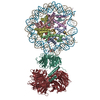
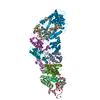

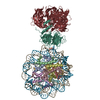

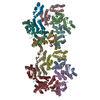
 PDBj
PDBj





























